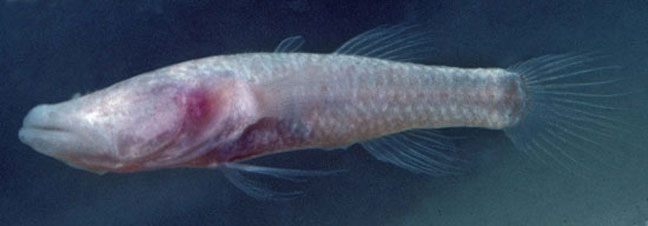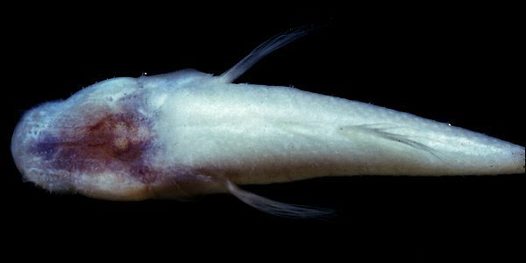
Milyeringa veritas
FAMILY
Eleotridae
TAXONOMY
Milyeringa veritas Whitley, 1945, Milyering, Yardie, 20 mi (32
km) southwest of Vlamingh Head, North-West Cape, Western
Australia. Populations show a low degree of heterozygosity,
which is typical of cave-dwelling fishes. This species is possibly
closely related to the Indo-Pacific eleotrid genus Butis.
OTHER COMMON NAMES
English: Cave gudgeon.
PHYSICAL CHARACTERISTICS
Reaches about 2 in (5 cm) total length. The head is broad and
concave over the snout. The eyes are not visible. Small first
dorsal fin with four very short spines. Second dorsal fin with
nine longer rays. Pelvic fins separate. The caudal fin is slightly
pointed. The head is naked but the body is covered with small
scales (about 28 in series along the flanks). The fish is very
poorly pigmented. The top of the head is pale yellow, with a
dark gray triangular mark over the brain. The posterior nostrils
are pink. There is a purplish spot over the operculum.
The body is pale gray and fins are flesh colored.
DISTRIBUTION
Western and northeastern coastal plains of the Cape Range
Peninsula and Barrow Island, Western Australia.
HABITAT
This is a troglobitic species; i.e., an obligatory cave dweller,
found in shallow wells (at depths of up to 1.6 ft/0.5m), sinkholes,
and deeper cave systems (at depths of up to 105 ft/32 m)
that are freshwater or anchialine (located near the sea and
flooded with sea water). In anchialine systems the fishes may
live in freshwater layers that overlie the salt water. They are
also found in brackish water, tolerating salinities from 0.27–34
parts per thousand and temperatures of 70–83°F (21–28°C).
BEHAVIOR
Swims slowly, with the pectorals pointed out to the sides and
the pelvics extended slightly forward.
FEEDING ECOLOGY AND DIET
Possibly feeds on insects or other small animals that drop into
the cave waters.
REPRODUCTIVE BIOLOGY
Random mating apparently occurs between subpopulations
throughout the range.
CONSERVATION STATUS
Listed as Data Deficient in the IUCN 2002 Red List, but as
threatened by the Western Australian Conservation Act. Major
threats come from habitats disturbance due to urban and agricultural
development, and water extraction causing a lowering
of the water table. Water quality in the underground systems is
being compromised by pollution from nutrients and other
chemicals.
SIGNIFICANCE TO HUMANS
None known.
Photo Gallery of - Blind cave gudgeon





 Animalia Life
Animalia Life